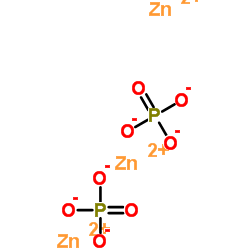Zinc phosphate

Zinc phosphate structure
|
Common Name | Zinc phosphate | ||
|---|---|---|---|---|
| CAS Number | 7779-90-0 | Molecular Weight | 386.170 | |
| Density | 3.99 | Boiling Point | 158ºC at 760 mmHg | |
| Molecular Formula | O8P2Zn3 | Melting Point | 900°C | |
| MSDS | Chinese USA | Flash Point | N/A | |
| Symbol |

GHS09 |
Signal Word | Warning | |
|
Radiopacity of different resin-based and conventional luting cements compared to human and bovine teeth.
Dent. Mater. J. 31(1) , 68-75, (2012) This study evaluated the radiopacity of different resin-based luting materials and compared the results to human and bovine dental hard tissues. Disc specimens (N=130, n=10 per group) (diameter: 6 mm, thickness: 1 mm) were prepared from 10 resin-based and 3 c... |
|
|
Microleakage of adhesive and nonadhesive luting cements for stainless steel crowns.
Pediatr. Dent. 33(7) , 501-4, (2011) This study's purpose was to compare the ability of 5 luting cements to reduce microleakage at stainless steel crown (SSC) margins on primary molar teeth.Standard preparations were performed on 100 extracted primary molar teeth for SSC restoration. After fitti... |
|
|
Survival of two post systems--five-year results of a randomized clinical trial.
Quintessence Int. 42(10) , 843-50, (2011) To assess the survival rate of two different post systems after 5 years of service with a prospective randomized controlled trial.One hundred patients in need of a post were studied. Half of the patients received long glass fiber-reinforced posts, while the o... |
|
|
The effect of endodontic access preparation on the failure load of lithium disilicate glass-ceramic restorations.
J. Prosthet. Dent. 106(5) , 328-36, (2011) Endodontic access preparation through lithium disilicate ceramic restorations may damage the restoration and compromise its load-bearing capability.The purpose of this in vitro research was to investigate the effect of simulated endodontic access preparation ... |
|
|
Retentiveness of various luting agents used with implant-supported prostheses: a preliminary in vitro study.
Int. J. Prosthodont. 26(1) , 82-4, (2013) The aim of this preliminary in vitro study was to compare the retentiveness of a luting agent designed for use with dental implants to luting agents designed for use with tooth-retained restorations. The following luting agents were tested: (1) implant cement... |
|
|
Effect of axial wall modification on the retention of cement-retained, implant-supported crowns.
J. Prosthet. Dent. 107(2) , 80-5, (2012) Compromised angulation of implants may result in abutment preparation that is less than ideal. Compromised abutment preparation may affect the retention of implant-retained crowns.The purpose of this study was to investigate the effect of 5 implant abutment d... |
|
|
The Tucker technique: conservative molar inlays preserving the transverse ridge.
Oper. Dent. 37(1) , 93-7, (2012) Conservation of healthy tooth structure should be the aim of any restorative procedure. Two inlays may be an ideal choice for the treatment of maxillary molars to preserve the transverse ridge and maintain structural integrity. |
|
|
The influence of auxiliary features on the resistance form of short molars prepared for complete cast crowns.
J. Prosthet. Dent. 106(5) , 305-9, (2011) Several factors exist which result in crown preparations that are less than ideal. In these situations, the clinician should find a practical way to overcome the lack of resistance of the compromised tooth preparation.The purpose of this study was to evaluate... |
|
|
An in vitro radiographic analysis of the density of dental luting cements as measured by CCD-based digital radiography.
Quintessence Int. 43(5) , 421-8, (2012) According to the ISO, the radiopacity of luting cements should be equal to or greater than that of aluminum. The aim of this in vitro study was to determine the radiopacity of 13 commercially available dental luting cements and compare them with human enamel ... |
|
|
Microleakage along glass-fibre posts cemented with three different materials after cyclic loading: a pilot study.
Coll. Antropol. 37(2) , 431-5, (2013) The purpose of this in vitro study was to evaluate microleakage along glass-fibre posts cemented with three different cements after cyclic loading. After post-space preparation, fifty obturated root canals were randomly divided into three experimental groups ... |